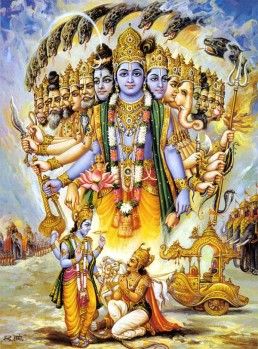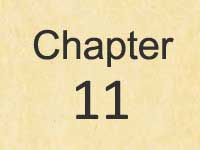
विश्वरूपदर्शनयोग
Viśva-Rūpa-Darśana-Yoga - The Cosmic Form
In this chapter, Lord Krishna gifts Arjuna the divine vision which enables him to perceive the Lord in His Cosmic form – a form that even the Gods long to see but are unable to. The bulk of the chapter comprises of Arjuna describing the various sights he beholds within the Lord’s form. Whereas the previous chapter showcased the manifestations of the One Supreme Self in the many, this chapter completes the narrative by driving home the point that those many forms are, in fact, sustained in and part of that One Self, which alone is the reality. Below are the main themes of Chapter 11:
Verses 1 - 4
Arjuna desires to see the universal form
Verses 5 - 8
Kṛṣṇa grants the divine eye
Verses 9 - 14
Sañjaya’s description of the universal form
Verses 15 - 22
Arjuna’s description of the universal form(first phase expressing wonder)
Verses 23 - 30
Arjuna’s description of the universal form (second phase expressing fear)
Verses 31 - 34
Kṛṣṇa answers Arjuna’s question
Verses 35 - 45
Arjuna’s description of the universal form(third phase expressing devotion)
Verses 46 - 55
Withdrawal of the universal form and glorification of devotion
Gita Chapter 11 - 55 Verses
Chapter 11 - 55 Verses
Commentary by Swami Paramarthananda
Background
(In the previous four chapters, Kṛṣṇa established that the entire uni-verse is a manifestation of God and, therefore, any glory in the cre-ation belongs to God alone. Now, in this chapter, Arjuna appreciates this teaching and sees the universe as the very Lord.)
In the first two verses, Arjuna summarizes the entire teaching of Kṛṣṇa – the nature of jīva (predominantly discussed in the first six chapters) and the nature of God (predominantly discussed in the later four chapters). Though Arjuna has received the teaching, he is unable to appreciate the universal form due to some mental blocks. Hence, he prays to the Lord for the vision of the universal form of the Lord (3, 4).
Lord Kṛṣṇa agrees to bless Arjuna with the vision of the univer-sal form (5 to 7). Since this is not possible to have such a vision with the ordinary eyes, Kṛṣṇa grants Arjuna the divine eye for this special purpose (8). (Universal form is not a special form of the Lord. It is the Lord as the universe. As such, it is available for all at all times. The Lord need not show it. Still we miss it because of our narrow outlook of the world. Once we refine our mind and look at the universe, we cannot miss the Lord. His stamp is there in all, from a blade of grass to the farthest star. Such a mind which is tuned to see the Lord is the divine eye behind the fleshy eyes. It is such an eye that Kṛṣṇa granted to Arjuna.)
From the 9th to the 14th verse, we get a description of the uni-versal form from Sañjaya. He picturises the Lord as a person with all divine ornaments shining with the brilliance of a thousand suns risen together. (We should remember that this is a description of the world only, divinised by the change of outlook. Every exalted object in the creation should be taken as an ornament of the Lord.)
From the 15th verse, we get Arjuna’s appreciation of the uni-versal form. (Arjuna goes through the various phases as he sees the universal form. The first response is one of wonder only.) Arjuna sees all beings in the cosmic body of the Lord. The sun and the moon are like his eyes. He sees the hands, legs, etc., of the people as those of the Lord. Now, the Lord’s body with thousands of hands, legs, etc., appears without beginning, middle or end (15 to 22).
Now Arjuna’s attention is turned towards the mouth of the Lord which represents Time (Death). With blazing fire and protruding teeth, the Lord’s mouth evokes terror in all, including Arjuna. Arjuna sees the entire world being scorched by this fire (Time), while many are rushing towards the mouth of the Lord. Some are already inside the mouth and some are crushed between the teeth. All these cause great fear and confusion in Arjuna and he begins to doubt whether the Lord is a loving father or a terrible destroyer (23 to 31). (This shows that Arjuna is still not able to see the Lord as a whole. He is able to accept ‘birth’ as part of the universe, but not ‘death’. This partial outlook is the cause of fear and confusion. This is the second phase.)
Then, the Lord clarifies that the fierce aspect also is Himself, manifesting as the Time-principle. When the time comes for people to die, the Lord finds the instruments to bring this about and Arjuna happens to be one of them in the hands of the Lord (32 to 34). Having understood the Lord to be ‘the cosmic-stage-manager’, Arjuna surren-ders to His Will and sings His glory (34-45). (Now Arjuna appreciates the Lord as totality, the basis of creation-preservation-dissolution. In front of the Lord everything else is insignificant. This appreciation makes him a devotee, seeking forgiveness for all his past omissions and commissions. Thus, the third phases is true devotion to the Lord, born out of right understanding).
Arjuna is indeed happy to have this unique vision of the Lord. Still, one part of his mind is not able to accept the totality, especially the destructive aspect. So Arjuna requests the Lord to withdraw his form (46).
In the last nine verses (47 to 55), we see the Lord withdrawing His universal form (i.e., the Lord takes away the divine eye that Arjuna enjoyed till now. Arjuna comes down to look at the world in his own private way.) The Lord praises devotion as a means to this cosmic vision. This universal form could be seen by Arjuna because of his devotion. Through devotion one can purify the mind, see the universal form, know the true nature of the Lord, and become one with the Lord.
Hence, Kṛṣṇa tells Arjuna – “Do actions for My sake; be My devotee; keep Me as the ultimate goal; be detached (from the world); be free from hatred towards all. Such a person reaches Me.”
The important topics discussed in this chapter are:
- Arjuna desires to see the universal form: 1 to 4
- Kṛṣṇa grants the divine eye: 5 to 8
- Sañjaya’s description of the universal form: 9 to 14
- Arjuna’s description of the universal form(first phase expressing wonder): 15 to 22
- Arjuna’s description of the universal form (second phase expressing fear): 23 to 30
- Kṛṣṇa answers Arjuna’s question: 31 to 34
- Arjuna’s description of the universal form(third phase expressing devotion): 35 to 45
- Withdrawal of the universal form and glorification of devotion: 46 to 55
Since this chapter deals with the universal form of the Lord, it is called Viśvarūpadarśana-yoga.

